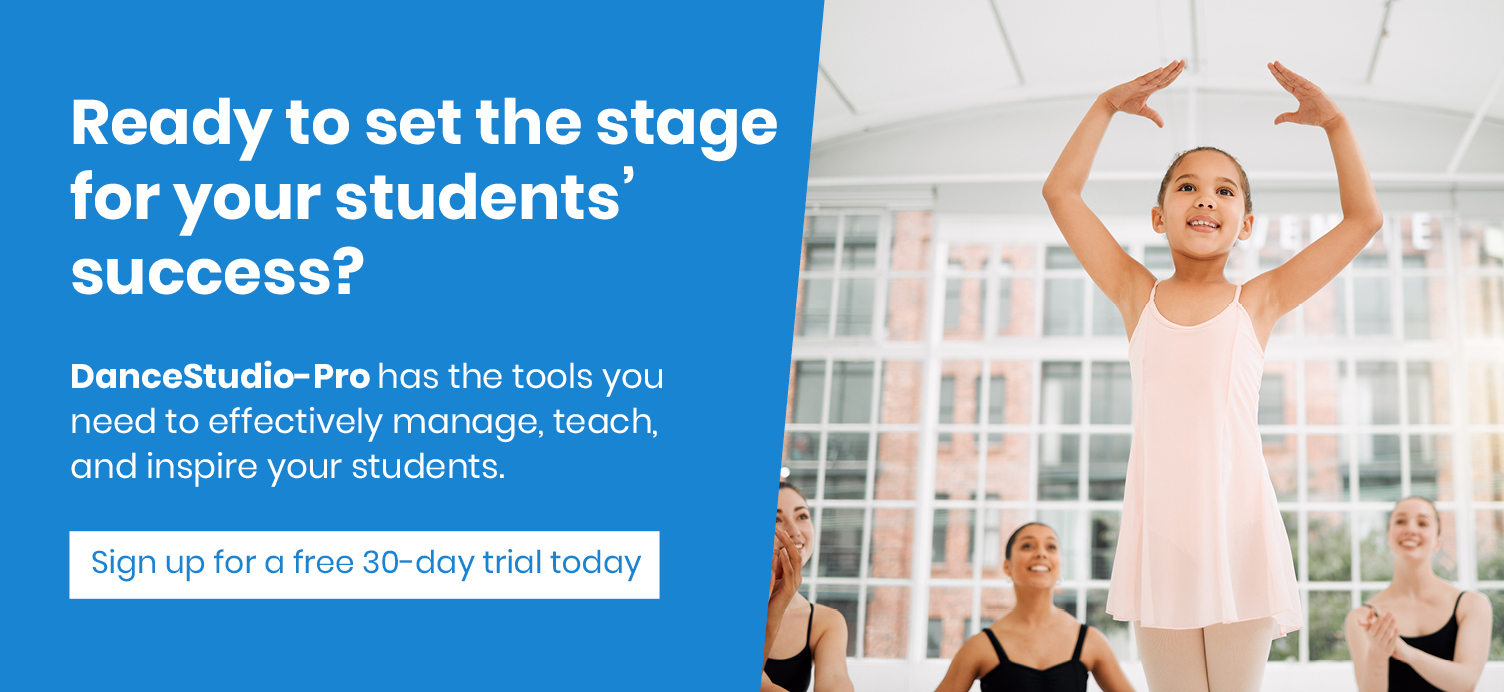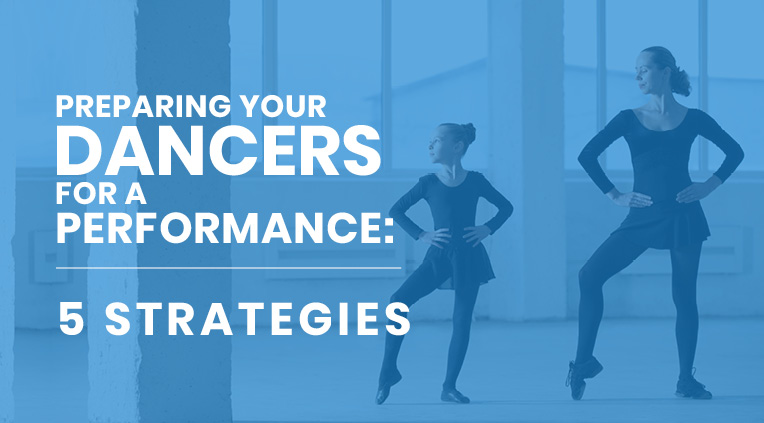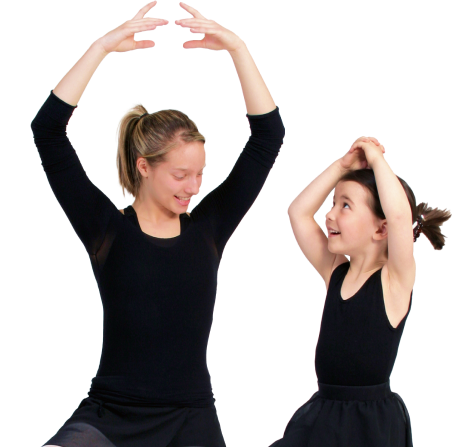For a dancer, there’s nothing quite like the feeling of stepping onstage to perform. Full of anticipation, a dancer will look out over the awaiting audience as the first few notes of music begin to fill the air—music that the dancer has come to know like the back of their hand thanks to hours of practice. The lights come up, the dancer assumes their first position, and then they dazzle the crowd.
Though performing can be like this—magical, rewarding, and fulfilling—as a dance teacher you know that it can take great amounts of time and preparation to get dancers to feel confident enough to enjoy the experience and give it their all.
So, what can you do to help your dancers as they’re prepping for a competition, recital, audition, or showcase? In this guide, we’ll give you five strategies to implement well ahead of your next performance:
- Maintain a regular rehearsal schedule, but don’t overdo it.
- Encourage rest and nutrition.
- Equip dancers with tools for combating stage fright.
- Create a pre-performance checklist.
- Remind your dancers what it’s all about—fun!
While these strategies will be especially helpful for young performers who are new to the stage, don’t overlook their value for experienced competition teams, community performance troupes, and even high schoolers preparing to submit college audition prescreen videos. Even the most seasoned dancers can benefit from tuning up their performance preparation regimens!
Let’s jump right in!

1. Maintain a regular rehearsal schedule, but don’t overdo it.
It’s a no-brainer that to successfully perform, your dancers must know their dances inside and out. This helps dancers stay motivated, gain confidence, and learn how to work together as a team. Thus, rehearsals become part of the pre-performance logistics (just like using an audition scheduling tool to sign up for a big school audition or making sure costume alterations are completed in advance).
For effective rehearsals, you should stick to a regular schedule. If you’ll be scheduling a couple of extra rehearsal times outside of your regular class times, let your dancers (and their parents) know well in advance so they can plan accordingly.
Here are some tips to get the most out of your rehearsal time:
- Start on time. Especially when you’re getting closer to a highly-anticipated performance, every second counts. Make sure you’re starting each class or rehearsal on time so you can run dance numbers all the way through, pause for corrections, and accomplish your overall goals for the rehearsal. Communicate to your dancers that you need them to warm up and cool down before and after class so that you can be as efficient as possible.
- Lean into the power of repetition. Is your competition team lacking synchronization during a critical kickline? Is one of your ballet dancers just not nailing their arabesques? Don’t be afraid to take the time during rehearsal to have dancers run through problem areas multiple times. Repeatedly working through small mistakes will lead to a more polished final performance.
- Give your dancers notes at the end of each rehearsal. Need your class or team to practice something in front of the mirror in between rehearsals? Let them know what you want them to practice at home and make sure, especially for younger dancers, that your feedback gets recorded in a notebook or a phone!
Rehearsing is of the utmost importance before a big performance. But remember, there’s no need to overdo it, especially in the last few days or hours before your dancers take to the stage. An Olympic-hopeful runner would never, for example, run a marathon the morning of their qualifying race! Be mindful of how much you’re asking your dancers to do ahead of the performance—too much rehearsing can lead to burnout, self-doubt, and even physical injury.
2. Encourage rest and nutrition.
Performing is physically demanding. While taking care of their bodies should be a priority for dancers at all times, it’s especially critical if they want to do their best on stage.
As a dance teacher, you know the importance of taking care of yourself, and with students looking to you for guidance prior to a performance, you have the opportunity (and responsibility!) to encourage them to get the rest and nutrition they need.
Encourage dancers and their families to implement a regular sleep schedule. Dancers and their parents should learn how much sleep they need and strive to make healthy sleep habits a priority. You can also recommend dancers practice good sleep hygiene by:
- Avoiding blue light (from phone screens, computers, and tablets) before bed
- Practicing meditation
- Keeping bedrooms dark and cool to encourage higher-quality sleep
In addition to getting great sleep, dancers should also be fueling their bodies with nutritious foods. Provide dancers and their families with lists of suggested meals and snacks or set up team or class potluck dinners ahead of the performance. In general, dancers should be eating foods containing protein and carbohydrates which will provide them with the energy they need to give their dancing their all!
3. Equip dancers with tools for combating stage fright.
It’s one thing to not know your choreography, but it’s another issue entirely when dancers become paralyzed with fear under the stage lights. Stage fright can be a big roadblock for dancers, and it’s a topic worth covering thoroughly in classes and workshops leading up to a show, audition, competition, or recital.
You might even set up an “Overcoming Stage Fright” camp dancers can enroll in so you can work on stage resiliency together in more depth. Here are some suggested activities you could incorporate into a stage fright prevention camp:
- Teach mindfulness techniques. From meditation to breathing exercises and positive visualization, there are a number of techniques dancers can employ to root themselves in the moment right before performing. Try a breathing exercise together or have dancers say affirmations to keep the confidence coming and to encourage a feeling of calm. You might even incorporate relaxing essential oils into your mindfulness practice together, like lavender or peppermint!
- Invite experienced dancers to share their stories about overcoming stage fright. Sometimes hearing from peers about stage fright experiences can help dancers know that they’re not alone in being anxious about dancing on stage. Ask a few of your older or more experienced dancers to share candid stories about stage fright and offer their advice.
- Brainstorm ways to release nervous energy. Your dancers may feel the physical manifestations of pre-performance anxiety like getting “the jitters” before going out on stage. In your camp, come up with ways that your dancers can release that nervous energy. Maybe they enjoy doing jumping jacks, squeezing stress balls, or going for a brisk walk.
- Prepare for everything by teaching improvisation. Even the best, most well-known dancers have messed up on stage before! But just the thought of doing so can be paralyzing—unless dancers are ready for the situation. Practice improvisation with your dancers. For example, you might cut the music during rehearsal and encourage them to keep going!
Talking about stage fright and performance anxiety isn’t just a conversation for a day camp or a pre-performance pep talk. You should also talk about stage fright after the performance while the experience of being onstage is still fresh. Learn from your dancers what coping mechanisms worked and what didn’t, and strive to come up with additional ways to ride out the nerves together.
4. Create a pre-performance checklist.
When your dancers are a few days away from performing, you should create a pre-performance checklist of tasks they’re responsible for completing before the big day. This will help dancers and their families stay organized and avoid getting overwhelmed before the show.
Here are a few examples of what you might include on your pre-performance checklist:
- Locate everything you will be wearing for the performance. This includes costumes, accessories, makeup, and dance shoes. Putting everything in one place ahead of time will ensure no dancers are missing hairbows or shoes on the day of the performance. (Which means less stress for you and dancers’ parents.)
- Prepare any necessary audition materials. Dancers may need to create resumes, edit music files to accommodate time limits, or even prepare monologues and songs if they’re auditioning for musical theater. Also, Acceptd’s guide to audition headshots emphasizes the importance of printing out multiple copies of 8x10 professional headshots before a big audition.
- Arrive at the performance venue at this specific time. Make it clear when dancers and their families need to be backstage ahead of the show or competition. You should allow ample time for getting dressed, stretching, and doing a couple quick run throughs of the dance or dances.
In addition to these three checklist items, you could include reminders to bring nutritious snacks to share backstage, protocol for picking dancers up after a big performance, and audience behavior (like whether pictures and videos are allowed during the show).
5. Remind your dancers what it’s all about—fun!
Performances are important because they allow dancers to show off what they’ve learned in their classes and challenge themselves, and sometimes performing even opens up new and exciting doors of opportunity in the world of dance.
But one single experience on stage won’t define someone’s entire dancing career, no matter if they bump into a fellow performer or have a flawless performance.
That’s why it’s important to stay positive and remind your dancers to have the time of their lives while they’re out on stage. After all, this is why they’re taking dance classes from you—to have fun!
This important reminder will help your dancers focus on enjoying the experience, whether they’re performing for a national competition or a local school fundraiser. And, ultimately, as a dance teacher, you want your dancers to come out of every performance feeling excited to return to class and the stage.
Focusing on the enjoyable aspects of performing, like unique pre-performance rituals (such as team cheers and songs), post-show parties, pictures with dance friends, and the exhilaration of bringing your best to the dance floor will go a long way in helping you to foster a positive studio culture and empower each and every dancer to love dancing.
As a dance teacher, you know that preparing your dancers for a performance is no small feat. But, by leveraging these five strategies, you can prepare your dancers for success and set them up to have a wonderful time doing what they love under the bright stage lights!

About the Author
This is a guest post by Emily Hucle at Acceptd. Emily Hucle is the Operations Director of Acceptd, a Togetherwork company that is the premier recruitment, application, and audition platform for the arts. In her free time, Emily enjoys decorating homes and events, creating floral arrangements, and attending concerts and shows.








